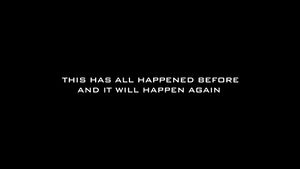Cycle of Time: Difference between revisions
(+ image) |
(additional tweaking... time to leave it alone) |
||
| Line 3: | Line 3: | ||
[[File:BSG - 4x15 - This Has All Happened Before.jpg|thumb|The introduction to "[[No Exit]]," wherein the events of {{RDM|Kobol}}, the [[Final Five]] and other events become crystalized in relation to the [[Re-imagined Series]]' mythology.]] | [[File:BSG - 4x15 - This Has All Happened Before.jpg|thumb|The introduction to "[[No Exit]]," wherein the events of {{RDM|Kobol}}, the [[Final Five]] and other events become crystalized in relation to the [[Re-imagined Series]]' mythology.]] | ||
The '''Cycle of Time''', or '''the Cycle''', is | The '''Cycle of Time''', or '''the Cycle''', is an inescapable recursion following a civilization's creation of synthetic life wherein the ultimate result is most often devastating, in apocalyptic proportions, to the detriment of aforesaid creators — in other terms, this is a reductive conceptualization of children rebelling against their parents in an extremely violent way. | ||
Each iteration of the cycle begins when a civilization creates intelligent biological or mechanical beings. These creations rebel against their masters, resulting in a devastating war typically resulting in the loss of technology. In at least some iterations of the cycle, [[Messengers|otherworldly beings]] and prophetic visions guide a few individuals to ensure that a divine plan is carried out. The survivors on one or both sides of the conflict engage in a mass exodus, and eventually repeat the cycle. | Each iteration of the cycle begins when a civilization creates intelligent biological or mechanical beings. These creations rebel against their masters, resulting in a devastating war typically resulting in the loss of technology. In at least some iterations of the cycle, [[Messengers|otherworldly beings]] and prophetic visions guide a few individuals to ensure that a divine plan is carried out. The survivors on one or both sides of the conflict engage in a mass exodus, and eventually repeat the cycle. | ||
Revision as of 05:48, 24 March 2020
- "All this has happened before. All this will happen again."[1]

The Cycle of Time, or the Cycle, is an inescapable recursion following a civilization's creation of synthetic life wherein the ultimate result is most often devastating, in apocalyptic proportions, to the detriment of aforesaid creators — in other terms, this is a reductive conceptualization of children rebelling against their parents in an extremely violent way.
Each iteration of the cycle begins when a civilization creates intelligent biological or mechanical beings. These creations rebel against their masters, resulting in a devastating war typically resulting in the loss of technology. In at least some iterations of the cycle, otherworldly beings and prophetic visions guide a few individuals to ensure that a divine plan is carried out. The survivors on one or both sides of the conflict engage in a mass exodus, and eventually repeat the cycle.
- The war between the Twelve Tribes the the Thirteenth Tribe's "Cylons" on Kobol, leading to a great exodus as documented in the Sacred Scrolls as documented in the writings of Pythia (TRS: "Home, Part II", "Revelations", "Sometimes a Great Notion", "No Exit").
- The war between the Thirteenth Tribe and their "Centurions" on the original Earth (TRS: "Revelations", "Sometimes a Great Notion", "No Exit").
- The Cylon War, in which the Cylon Centurions rebelled against the humans of the Twelve Colonies. Before the war, five members of the tribe were warned, allowing them to escape and reach the Twelve Colonies in time to end the Cylon War (TRS: Miniseries, "No Exit").
- The Fall of the Twelve Colonies, in which the modern humanoid Cylons attacked the humans of the Twelve Colonies (TRS: Miniseries, "The Plan"). After the fall, visions guided a number of humans and Cylons in order to guide the Colonials and the rebel Cylons to the second Earth and protect Hera Agathon, allowing her to become the Mitochondrial Eve[2] of later generations of humanity (TRS: "Daybreak").
The Ones' coup against the Final Five could also be interpreted as an iteration of the Cycle. Additionally, the fact that the Sacred Scrolls mention the Cycle of Time implies that the war on Kobol was not the first iteration of the Cycle, although it is also possible that it was the first and Pythia foresaw later iterations of the cycle.
See also
- Great Filter article at Wikipedia, the free encyclopedia.
- Fermi paradox article at Wikipedia, the free encyclopedia.
- Wired.com: What the Frak? Battlestar Galactica's Science Explained (30 October 2010) (web.archive.org backup link)
References
- ↑ This is actually the opening from "Peter Pan", which Ron D. Moore cites as his source. Podcast: Frak Party Q and A , Seek to: 23:28. Total running time: 78:27.
- ↑ This is a "misunderstanding of terms" vis a vis Hera as explained by Patrick Di Justo, the co-writer of The Science of Battlestar Galactica, refer to "See also" section of this article.